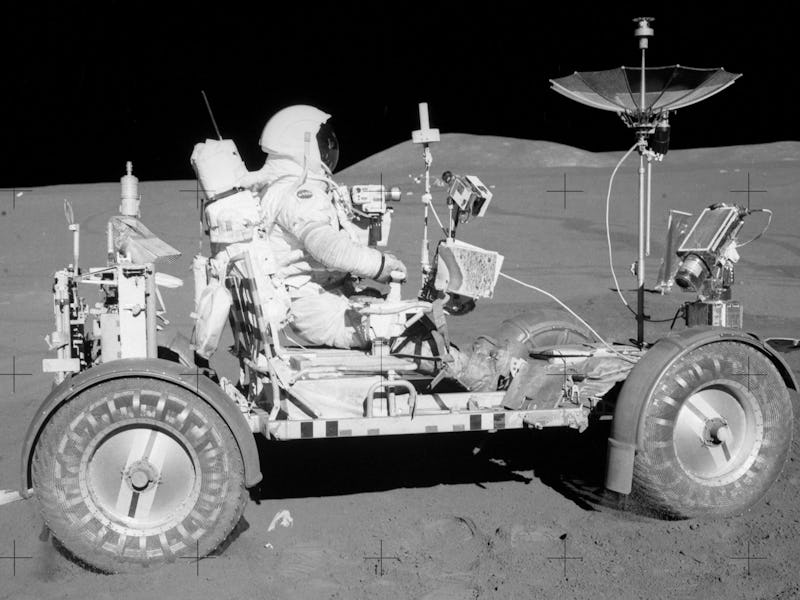It's Been 45 Years Since the First Lunar Rover Drove on the Moon
Celebrating 45 years of driving in space.

America loves space and cars, so what’s better than cars in space? Today, July 31 is the 45th anniversary of the first Lunar Rover drive by NASA astronaut Dave Scott during the Apollo 15 mission. Since then, rover technology has been advancing for the next stages of planetary exploration.
The Lunar Roving Vehicle (LRV) as a concept was tossed around well before even the Apollo 11 mission put humans on the moon. Wernher von Braun envisioned manned vehicles on the moon, and started the task force behind development of the Lunar Rover a few years before the Apollo 15 mission in 1971. Boeing, Bendix, Grumman, and Chrysler all submitted proposals for developing a lunar rover. It was a contract that Boeing ultimately won, with General Motors as a subcontractor providing the mobility systems.
Four lunar rovers were built by Boeing for $38 million. An overrun of the original $19 million proposal, but within the limits of NASA’s original estimates. One rover was built for each of NASA’s J-Class (longer than 3 days) missions: Apollo 15, 16, and 17. The rover could be folded into a more compact, five feet long by twenty inches wide. The rover weighed 1,500 pounds when fully loaded and crewed by two astronauts (an empty rover weighed at 460 pounds). It had wheels which were independently driven by a 200-watt, quarter horsepower electric motor.
It was first used on July 31, 1971 during the Apollo 15 mission. The rover was controlled by commander David Scott for a distance of 17.25 miles. The rover was driven for three hours total during the mission. While it didn’t encounter technical problems during the Apollo 15 expedition, mission parameters stated that the rover could only be driven as far as walking distance in case of break-down.
The rovers were delivered to the Moon’s surface via the Apollo Lunar Module. Since the rovers couldn’t be taken back to Earth, the rovers across the three J-Missions remain as artificial elements on the Moon’s surface. Commander Scott drove the Lunar-1 to transport him, fellow astronaut James Irwin, and their equipment along the Hadley Rille and Apennine Mountains. Thanks to the rover, the team was able to collect 180 pounds of lunar surface material.
The Martian (2015)
These days, space travel enthusiasts are more familiar with hearing about uncrewed, robotic rovers. NASA’s Curiosity rover is currently on a mission looking for signs of life on Mars, while the Chinese CNSA’s Chang’e 3 is also on an unmanned mission on Mars.
The film The Martian however, involved Matt Damon’s stranded astronaut, Mark Watney, using a fictional Mars rover to make his way to actual Mars probe Pathfinder. Incidentally, the Mars Pathfinder carried along with it a robotic rover named Sojourner.
The red planet doesn’t yet have a human-made rover on its surface, but the idea is being explored for an eventual manned mission to Mars. A Mars Rover design put forth by Montgomery Design International and Ergonomic Systems Design won the Chicago Atenaum’s Good Design Award in 2009. The Manned Mars Exploration Rover (MMER) was designed to act as a habitable vehicle for extended missions on Mars.
For now, though, the future of rovers appear to be robotic and unmanned as these lonely vehicles continue their missions to far-off planets.